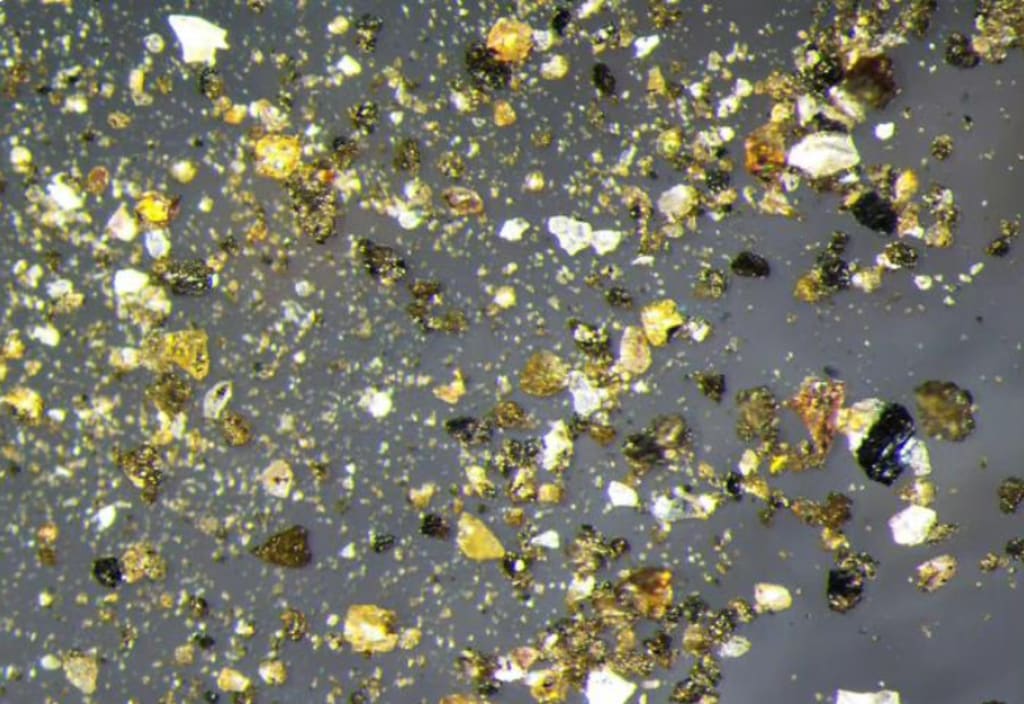Heavyweight! Chang'e 5: Newly discovered "Chang'e rocks" on the Moon, lunar soil helium-3 extraction parameters determined
Newly discovered "Chang'e stone" on the moon

Chinese scientists have had great success in the lunar samples brought back by Change-5, discovering a previously unknown mineral and confirming for the first time the content and extraction conditions of an extremely rare energy substance in the lunar soil, according to the National Space Administration of China.
Fifty years ago, NASA's Apollo spacecraft made six successful lunar landings, and the 12 astronauts who set foot on the lunar surface brought back a total of 381 kilograms of lunar soil and rocks. in 1978, the United States presented a lunar rock to China.
However, this lunar rock was very small, weighing only 1 gram. But it was still precious to the Chinese scientists at that time. It was a good opportunity to study the composition of the moon. At that time this lunar rock was cut into two halves, 0.5g of which was used for scientific research. The composition of the lunar rock was analyzed by the Institute of Atomic Energy of the China National Nuclear Corporation (CNNC), and the content of 36 elements was determined.
Finally, in 2020, China launched the Change 5 probe, which successfully landed on the front of the Moon and brought back 1.731 kg of lunar samples. The lunar sampling mission was a world-renowned event, as humans had not been to the Moon for decades, and the sampling area of Change-5 was very different from the previous Apollo missions.
Analysis shows that the Apollo lunar samples are all very old, basically over 3 billion years old, with the oldest reaching 4.44 billion years and the moon's formation estimated at 4.51 billion years ago. Although humans know something about the moon's distant past, they know nothing about its evolution in the last two to three billion years.
Change-5 went to a much younger region on the Moon, so by studying Change-5's lunar samples, gaps in the Moon's evolutionary history can be filled. Change 5 lunar surface samples have been distributed in several times, and many domestic research institutions are conducting a series of studies and analyses.
Previous studies have shown that the elemental composition and content of Change-5 lunar samples are significantly different from Apollo samples, and Chinese scientists have determined the content of more than 40 elements. As research progresses, scientists are increasingly discovering that lunar soil is a treasure trove of resources.
Change Rock
In the latest study, Chinese scientists have discovered a new lunar mineral in lunar basalt that looks like columnar crystals. Analysis shows that it is a phosphate mineral. Since this is the first discovery by Chinese scientists, we have the right to name this new mineral. It is called "Change Stone", which is in line with "Change Runs to the Moon" and "Change Moon Mission", and shows the cultural characteristics of China.
The lunar basalt also has a large amount of ilmenite. Chinese scientists predict that up to 30 kilograms of titanium can be extracted from each ton of lunar samples. Research by Chinese scientists suggests that ilmenite could also be used to make rocket fuel and the oxygen needed for future human survival on the moon.
Although the moon has no atmosphere and daytime surface temperatures can exceed 120 degrees Celsius, there is still water on the moon. Some water exists in the form of hydrates in the lunar soil; some water exists in the form of ice in the permanently shadowed regions of the Moon, and some craters do not reach the Sun, where the temperature can be as low as -220°C.
If the water on the Moon is extracted, using a titanium catalyst and solar energy, it can be broken down directly into hydrogen and oxygen. In addition, carbon dioxide and hydrogen can be synthesized into methane and methanol with the help of catalysts. Hydrogen, oxygen, and methane can be used as rocket fuel.
The Kripke rocks on the Moon are rich in rare earth elements, with estimated reserves of at least 20 billion tons, far exceeding the total reserves on Earth. There are many unique minerals on the Moon, such as the newly discovered "Change stone". As research progresses, it is believed that more unknown lunar minerals will be discovered.
Helium-3
The Moon also has a large amount of helium-3, the "perfect energy source" for controlled nuclear fusion. Helium-3 can replace tritium and react with deuterium in fusion to produce protons and helium-4. There is no nuclear radiation and the power generation is very efficient.
Scientists estimate that just 10 tons of helium-3 could produce enough energy to meet China's energy needs for a year, and 100 tons of helium-3 would be enough to power the world for a year. Each ton of helium-3 is worth up to $3 billion, or about $20.7 billion.
Helium-3 is extremely rare on Earth but is widely distributed on the Moon. There are at least 1.03 million tons of helium-3 reserves in the lunar soil, enough for all of humanity for tens of thousands of years. The reason for the abundance of helium-3 on the Moon is related to the source of helium-3.
Inside the Sun, four hydrogen nuclei constantly combine to form a helium nucleus, releasing enormous amounts of energy, which is why the Sun has been able to "burn" for 4.6 billion years. During the fusion process of the Sun, some helium-3 is also produced, which eventually diffuses into space as high-energy particles with the solar wind.
Because the Moon has no atmosphere, helium-3 can reach the Moon's surface directly. In the long run, a lot of helium-3 is already stored on the Moon. in addition to the Moon, more helium-3 is stored on Mercury, which has almost no atmosphere and is larger and closer to the Sun than the Moon.
Therefore, one of the major research objectives of the Change-5 lunar samples is to find the helium-3 contained in them. previous studies by Chinese scientists have confirmed that helium-3 is indeed present in large amounts in the lunar soil. this time, for the first time, Chinese scientists have measured the amount of helium-3 in the Change-5 lunar samples. More importantly, for the first time, we have also obtained the extraction parameters of helium-3.
NASA Administrator Bill Nelson also paid great attention to the Change-5 lunar samples. He said China should share it with the world. NASA is also anxious now. The new generation of lunar rockets is constantly failing and the first flight has been delayed again and again.
About the Creator
Carlo Phil
Science and art are two sides of a coin






Comments
There are no comments for this story
Be the first to respond and start the conversation.